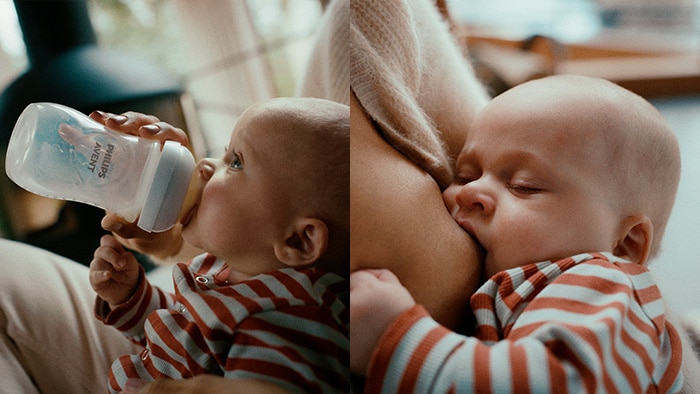Reading Time: 5 Min
Why letting baby control the milk flow matters when you’re bottle feeding
Oh baby. There are so many things to get your head around when it comes to bottle feeding. So, we’re going to keep it simple and focus on helping your baby feel calm and comfortable. From research, we know that one of the best ways to do this is to help them use a natural drinking rhythm, like they would if they were drinking at the breast. This guide will help you understand what a natural drinking rhythm is and how to encourage it, whether you’re combining breast and bottle or exclusively bottle feeding.
How babies drink
Let’s start with the basics of how babies naturally drink. If you were to watch a baby drink in slow motion, you’d notice that they use a suck, swallow and breathe pattern when drinking at the breast. Milk only releases when they apply pressure to the breast. That way they’re always in control of the flow and can drink with their normal rhythm.
Why it matters when you’re bottle feeding
Traditional bottles allow milk to flow as soon as they’re tilted downwards. The milk flow then is continuous and doesn’t stop. This doesn’t give babies a chance to pause to swallow milk and take breathe at their own pace. Being in control of the flow, like when they’re breastfeeding, helps babies feel calm and comfortable. We designed the Natural Response Nipple to do just that, for successful breast and bottle feeding. Our Natural Response nipple is designed to do just that. Unlike a traditional nipple, it only opens and releases milk when your baby applies suction. When they stop swallow and take a breathe the milk flow stops.
Think about cues rather than age
If you’ve been using traditional baby bottles, you’ll be used to choosing nipple flows based on your baby’s age. When it comes to baby bottles that let babies use their natural drinking rhythm, your best guide is how your baby likes to drink.
Enthusiastic drinkers use strong suction and compression as they drink, which results in more milk flow. That’s why they usually need a lower nipple flow from the Natural Response range (such as nipple number 1 or 2) to avoid overflow.
Slow and steady drinkers, on the other hand, are more likely to prefer a higher nipple flow (such as nipple 4 or 5) to ensure enough milk flows, regardless of their age.
If you’ve been using our traditional Natural nipple, this table will give you an idea of how the nipple flows differ. Keep in mind there’s no perfect translation because they work differently. It’s more of a loose guide.
From previous Natural nipple
To new Natural Response nipple
First flow (0m) (number 0)
Flow 2
Newborn flow (0m+) (number 1)
Flow 3
Slow flow (1m+) (number 2)
Flow 4
Medium flow (3m+) (number 3)
Flow 5
Fast flow (6m+) (number 4)
Flow 5
Give your baby time to adjust
Although it’s a natural drinking action, it’s completely normal for babies to take some time to adjust to a bottle that works this way. If your baby is used to a traditional bottle nipple, they’ll need to adjust their technique. And like anything new, practice makes perfect. As a basic guide, expect around three separate feeding attempts for your baby to fully adjust. You can make it easier for both of you by initially offering the new bottle nipple in between two feeds, before your baby is very hungry. They’ll feel motivated to feed, but not so much that they’ll become frustrated if they don’t first succeed.
Baby knows best
Of course, when you’re starting out it’s hard to know exactly how your baby likes to drink. We recommend starting with the nipple that comes with the bottle and if after a few tries your baby still isn’t accepting the nipple, try a different, perhaps higher, flow rate. You’ll know you’ve found the right nipple for your baby when they’re calm and comfortable throughout the feed.









